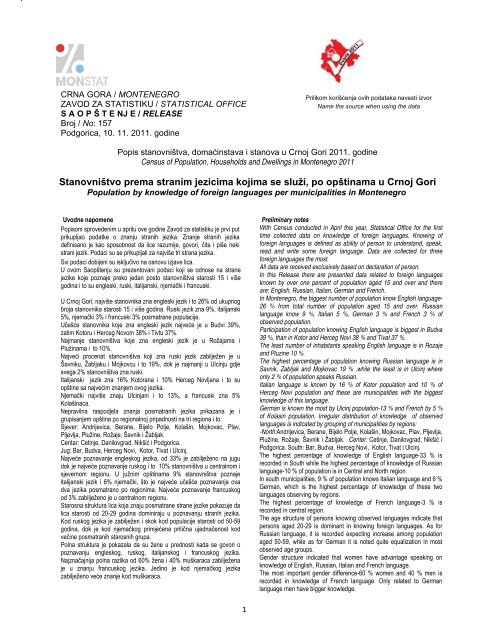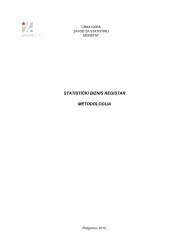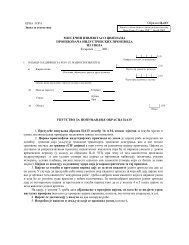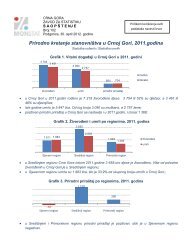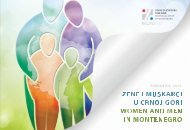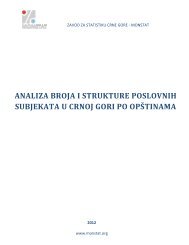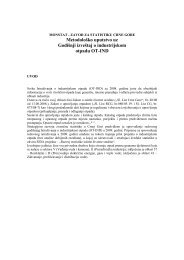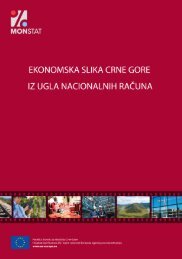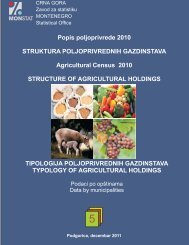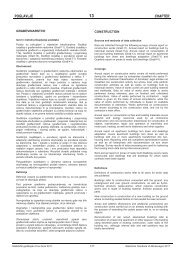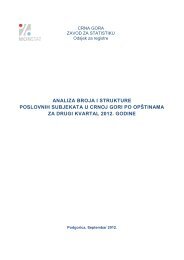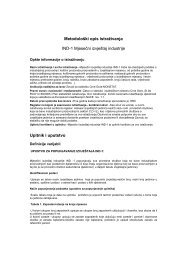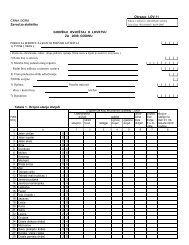Znanje stranih jezika - Monstat
Znanje stranih jezika - Monstat
Znanje stranih jezika - Monstat
Create successful ePaper yourself
Turn your PDF publications into a flip-book with our unique Google optimized e-Paper software.
CRNA GORA / MONTENEGRO<br />
ZAVOD ZA STATISTIKU / STATISTICAL OFFICE<br />
S A O P Š T E NJ E / RELEASE<br />
Broj / No: 157<br />
Podgorica, 10. 11. 2011. godine<br />
Prilikom korišćenja ovih podataka navesti izvor<br />
Name the source when using the data<br />
Popis stanovništva, domaćinstava i stanova u Crnoj Gori 2011. godine<br />
Census of Population, Households and Dwellings in Montenegro 2011<br />
Stanovništvo prema stranim jezicima kojima se služi, po opštinama u Crnoj Gori<br />
Population by knowledge of foreign languages per municipalities in Montenegro<br />
Uvodne napomene<br />
Popisom sprovedenim u aprilu ove godine Zavod za statistiku je prvi put<br />
prikupljao podatke o znanju <strong>stranih</strong> <strong>jezika</strong>. <strong>Znanje</strong> <strong>stranih</strong> <strong>jezika</strong><br />
definisano je kao sposobnost da lice razumije, govori, čita i piše neki<br />
strani jezik. Podaci su se prikupljali za najviše tri strana <strong>jezika</strong>.<br />
Svi podaci dobijeni su isključivo na osnovu izjave lica.<br />
U ovom Saopštenju su prezentovani podaci koji se odnose na strane<br />
jezike koje poznaje preko jedan posto stanovništva starosti 15 i više<br />
godina i to su engleski, ruski, italijanski, njemački i francuski.<br />
U Crnoj Gori, najviše stanovnika zna engleski jezik i to 26% od ukupnog<br />
broja stanovnika starosti 15 i više godina. Ruski jezik zna 9%, italijanski<br />
5%, njemački 3% i francuski 3% posmatrane populacije.<br />
Učešće stanovnika koje zna engleski jezik najveće je u Budvi 39%,<br />
zatim Kotoru i Herceg Novom 38% i Tivtu 37%.<br />
Najmanje stanovništva koje zna engleski jezik je u Rožajama i<br />
Plužinama i to 10%.<br />
Najveći procenat stanovništva koji zna ruski jezik zabilježen je u<br />
Šavniku, Žabljaku i Mojkovcu i to 19%, dok je najmanji u Ulcinju gdje<br />
svega 2% stanovništva zna ruski.<br />
Italijanski jezik zna 16% Kotorana i 10% Herceg Novljana i to su<br />
opštine sa najvećim znanjem ovog <strong>jezika</strong>.<br />
Njemački najviše znaju Ulcinjani i to 13%, a francuski zna 5%<br />
Kolašinaca.<br />
Nepravilna raspodjela znanja posmatranih <strong>jezika</strong> prikazana je i<br />
grupisanjem opština po regionalnoj pripadnosti na tri regiona i to:<br />
Sjever: Andrijevica, Berane, Bijelo Polje, Kolašin, Mojkovac, Plav,<br />
Pljevlja, Plužine, Rožaje, Šavnik i Žabljak.<br />
Centar: Cetinje, Danilovgrad, Nikšić i Podgorica.<br />
Jug: Bar, Budva, Herceg Novi, Kotor, Tivat i Ulcinj.<br />
Najveće poznavanje engleskog <strong>jezika</strong>, od 33% je zabilježeno na jugu<br />
dok je najveće poznavanje ruskog i to 10% stanovništva u centralnom i<br />
sjevernom regionu. U južnim opštinama 9% stanovništva poznaje<br />
italijanski jezik i 6% njemački, što je najveće učešće poznavanja ova<br />
dva <strong>jezika</strong> posmatrano po regionima. Najveće poznavanje francuskog<br />
od 3% zabilježeno je u centralnom regionu.<br />
Starosna struktura lica koja znaju posmatrane strane jezike pokazuje da<br />
lica starosti od 20-29 godina dominiraju u poznavanju <strong>stranih</strong> <strong>jezika</strong>.<br />
Kod ruskog <strong>jezika</strong> je zabilježen i skok kod populacije starosti od 50-59<br />
godina, dok je kod njemačkog primjećena prilična ujednačenost kod<br />
večine posmatranih starosnih grupa.<br />
Polna struktura je pokazala da su žene u prednosti kada se govori o<br />
poznavanju engleskog, ruskog, italijanskog i francuskog <strong>jezika</strong>.<br />
Najznačajnija polna razlika od 60% žena i 40% muškaraca zabilježena<br />
je u znanju francuskog <strong>jezika</strong>. Jedino je kod njemačkog <strong>jezika</strong><br />
zabilježeno veće znanje kod muškaraca.<br />
Preliminary notes<br />
With Census conducted in April this year, Statistical Office for the first<br />
time collected data on knowledge of foreign languages. Knowing of<br />
foreign languages is defined as ability of person to understand, speak,<br />
read and write some foreign language. Data are collected for three<br />
foreign languages the most.<br />
All data are received exclusively based on declaration of person.<br />
In this Release there are presented data related to foreign languages<br />
known by over one percent of population aged 15 and over and there<br />
are: English, Russian, Italian, German and French.<br />
In Montenegro, the biggest number of population know English language-<br />
26 % from total number of population aged 15 and over. Russian<br />
language know 9 %, Italian 5 %, German 3 % and French 3 % of<br />
observed population.<br />
Participation of population knowing English language is biggest in Budva<br />
39 %, than in Kotor and Herceg Novi 38 % and Tivat 37 %.<br />
The least number of inhabitants speaking English language is in Rozaje<br />
and Pluzine 10 %.<br />
The highest percentage of population knowing Russian language is in<br />
Savnik, Zabljak and Mojkovac 19 % ,while the least is in Ulcinj where<br />
only 2 % of population speaks Russian.<br />
Italian language is known by 16 % of Kotor population and 10 % of<br />
Herceg Novi population and these are municipalities with the biggest<br />
knowledge of this language.<br />
German is known the most by Ulcinj population-13 % and French by 5 %<br />
of Kolasin population. Irregular distribution of knowledge of observed<br />
languages is indicated by grouping of municipalities by regions:<br />
-North:Andrijevica, Berane, Bijelo Polje, Kolašin, Mojkovac, Plav, Pljevlja,<br />
Plužine, Rožaje, Šavnik i Žabljak. Center: Cetinje, Danilovgrad, Nikšić i<br />
Podgorica. South: Bar, Budva, Herceg Novi, Kotor, Tivat i Ulcinj.<br />
The highest percentage of knowledge of English language-33 % is<br />
recorded in South while the highest percentage of knowledge of Russian<br />
language-10 % of population is in Central and North region.<br />
In south municipalities, 9 % of population knows Italian language and 6 %<br />
German, which is the highest percentage of knowledge of these two<br />
languages observing by regions.<br />
The highest percentage of knowledge of French language-3 % is<br />
recorded in central region.<br />
The age structure of persons knowing observed languages indicate that<br />
persons aged 20-29 is dominant in knowing foreign languages. As for<br />
Russian language, it is recorded expecting increase among population<br />
aged 50-59, while as for German it is noted quite equalization in most<br />
observed age groups.<br />
Gender structure indicated that women have advantage speaking on<br />
knowledge of English, Russian, Italian and French language.<br />
The most important gender difference-60 % women and 40 % men is<br />
recorded in knowledge of French language. Only related to German<br />
language men have bigger knowledge.<br />
1
Tabela 1. STANOVNIŠTVO STAROSTI 15 I VIŠE GODINA KOJE ZNA NEKI OD NAVEDENIH JEZIKA PO<br />
OPŠTINAMA I REGIONIMA, POPIS 2011<br />
Table 1. Population aged 15 and over, knowing some of mentioned languages by municipalies and regions, Census 2011<br />
Opština / Municipality<br />
Stanovništvo 15 i<br />
vise godina /<br />
Population of<br />
Montenegro<br />
aged 15 and over<br />
Engleski/<br />
English<br />
Ruski /<br />
Russian<br />
Italijanski/<br />
Italian<br />
Njemački/<br />
German<br />
Francuski /<br />
French<br />
Crna Gora / Montenegro 501278 12965 46316 24135 14041 12747<br />
0<br />
Andrijevica 4168 604 442 22 139 35<br />
Bar 34303 9451 1921 2627 1200 989<br />
Berane 26827 4652 1987 133 1363 600<br />
Bijelo Polje 36443 6550 4198 204 646 444<br />
Budva 15665 6164 1785 1392 1434 598<br />
Cetinje 14291 3294 705 1125 121 473<br />
Danilovgrad 15295 3414 2180 436 246 199<br />
Herceg Novi 25765 9721 1523 2624 1217 670<br />
Kolašin 7025 1281 1017 53 57 327<br />
Kotor 18849 7386 961 2950 475 537<br />
Mojkovac 7074 1275 1331 51 79 52<br />
Nikšić 58929 14440 8313 1920 653 1210<br />
Plav 10203 1581 534 51 308 193<br />
Pljevlja 26098 4013 3332 142 204 713<br />
Plužine 2799 284 423 14 9 11<br />
Podgorica 148102 45170 13127 8643 2758 4566<br />
Rožaje 16939 1744 654 41 560 385<br />
Šavnik 1776 212 351 11 9 9<br />
Tivat 11556 4268 635 1080 428 497<br />
Ulcinj 16113 3564 308 592 2105 220<br />
Žabljak 3058 582 589 24 30 19<br />
Centar / Center 236617 66318 24325 12124 3778 6448<br />
Jug/ South 122251 40554 7133 11265 6859 3511<br />
Sjever/ North 142410 22778 14858 746 3404 2788<br />
2
Tabela 1a. UČEŠĆE STANOVNIŠTVA KOJE ZNA NEKI OD NAVEDENIH JEZIKA U STANOVNIŠTVU<br />
STAROSTI 15 I VIŠE GODINA PO OPŠTINAMA I REGIONIMA, POPIS 2011<br />
Table 1a. Participation of population knowing some of mentioned languages in whole population, aged 15 and over by municipalities and<br />
regions, Census 2011<br />
Opština /<br />
Municipality<br />
Engleski /<br />
English<br />
Ruski /<br />
Russian<br />
Italijanski/<br />
Italian<br />
Njemački/<br />
German<br />
Francuski /<br />
French<br />
Crna Gora / Montenegro 25.9 9.2 4.8 2.8 2.5<br />
Andrijevica 14.5 10.6 0.5 3.3 0.8<br />
Bar 27.6 5.6 7.7 3.5 2.9<br />
Berane 17.3 7.4 0.5 5.1 2.2<br />
Bijelo Polje 18.0 11.5 0.6 1.8 1.2<br />
Budva 39.3 11.4 8.9 9.2 3.8<br />
Cetinje 23.0 4.9 7.9 0.8 3.3<br />
Danilovgrad 22.3 14.3 2.9 1.6 1.3<br />
Herceg Novi 37.7 5.9 10.2 4.7 2.6<br />
Kolašin 18.2 14.5 0.8 0.8 4.7<br />
Kotor 39.2 5.1 15.7 2.5 2.8<br />
Mojkovac 18.0 18.8 0.7 1.1 0.7<br />
Nikšić 24.5 14.1 3.3 1.1 2.1<br />
Plav 15.5 5.2 0.5 3.0 1.9<br />
Pljevlja 15.4 12.8 0.5 0.8 2.7<br />
Plužine 10.1 15.1 0.5 0.3 0.4<br />
Podgorica 30.5 8.9 5.8 1.9 3.1<br />
Rožaje 10.3 3.9 0.2 3.3 2.3<br />
Šavnik 11.9 19.8 0.6 0.5 0.5<br />
Tivat 36.9 5.5 9.3 3.7 4.3<br />
Ulcinj 22.1 1.9 3.7 13.1 1.4<br />
Žabljak 19.0 19.3 0.8 1.0 0.6<br />
Centar / Center 28.0 10.3 5.1 1.6 2.7<br />
Jug/ South 33.2 5.8 9.2 5.6 2.9<br />
Sjever/ North 16.0 10.4 0.5 2.4 2.0<br />
3
Tabela 2. STANOVNIŠTVO STAROSTI 15 I VIŠE GODINA KOJE ZNA NEKI OD NAVEDENIH JEZIKA PO<br />
STAROSTI, POPIS 2011<br />
Table 2. Population aged 15 and over knowing some of mentioned languages by age, Census 2011<br />
Starost / Age<br />
Stanovništvo<br />
15 i vise godina<br />
/ Population of<br />
Montenegro<br />
aged 15 and<br />
over<br />
Engleski/<br />
English<br />
Ruski /<br />
Russian<br />
Italijanski/<br />
Italian<br />
Njemački/<br />
German<br />
Francuski /<br />
French<br />
Crna Gora / Montenegro 501278 129650 46316 24135 14041 12747<br />
15-19 44093 29393 5940 6319 2151 2993<br />
20-29 88609 47640 10386 7778 2748 3107<br />
30-39 86374 28166 7433 4184 2157 1766<br />
40-49 83585 14161 8249 2360 2128 1104<br />
50-59 84836 7371 9689 1800 1986 1340<br />
60-69 56317 2139 3116 957 1995 1744<br />
70 i više/ 70 and<br />
over<br />
Nepoznato/<br />
Unknown<br />
57216 763 1497 735 870 691<br />
248 17 6 2 6 2<br />
Tabela 2a. STANOVNIŠTVO STAROSTI 15 I VIŠE GODINA KOJE ZNA NEKI OD NAVEDENIH JEZIKA<br />
PO STAROSTI, POPIS 2011<br />
Table 1. Population aged 15 and over knowing some of mentioned languages by age, Census 2011<br />
Starost / Age<br />
Stanovništvo<br />
15 i vise godina<br />
/ Population of<br />
Montenegro<br />
aged 15 and<br />
over<br />
Engleski/<br />
English<br />
Ruski /<br />
Russian<br />
Italijanski/<br />
Italian<br />
Njemački/<br />
German<br />
Francuski /<br />
French<br />
Crna Gora / Montenegro 100.0 100.0 100.0 100.0 100.0 100.0<br />
15-19 8.8 22.7 12.8 26.2 15.3 23.5<br />
20-29 17.7 36.7 22.4 32.2 19.6 24.4<br />
30-39 17.2 21.7 16.0 17.3 15.4 13.9<br />
40-49 16.7 10.9 17.8 9.8 15.2 8.7<br />
50-59 16.9 5.7 20.9 7.5 14.1 10.5<br />
60-69 11.2 1.6 6.7 4.0 14.2 13.7<br />
70 i više / and<br />
over<br />
Nepoznato /<br />
Unknown<br />
11.4 0.6 3.2 3.0 6.2 5.4<br />
0.0 0.0 0.0 0.0 0.0 0.0<br />
4
Tabela 3. STANOVNIŠTVO STAROSTI 15 I VIŠE GODINA KOJE ZNA NEKI OD NAVEDENIH JEZIKA PO<br />
STAROSTI, POPIS 2011<br />
Table 3. Population aged 15 and over knowing some of mentioned languages by age, Census 2011<br />
ENGLESKI /<br />
English<br />
Ukupno/<br />
Total<br />
Starosne grupe / Age group<br />
15-19 20-29 30-39 40-49 50-59 60-69<br />
70 i više /<br />
70 and over<br />
Nepoznato<br />
/ Unknown<br />
Svega/ All 129650 29393 47640 28166 14161 7371 2139 763 17<br />
% 100.0% 22.7% 36.7% 21.7% 10.9% 5.7% 1.6% 0.6% 0.0%<br />
Muško/ male 61456 14101 22254 12703 6754 3770 1350 516 8<br />
% 47.4% 48.0% 46.7% 45.1% 47.7% 51.1% 63.1% 67.6% 47.1%<br />
Žensko / female 68194 15292 25386 15463 7407 3601 789 247 9<br />
% 52.6% 52.0% 53.3% 54.9% 52.3% 48.9% 36.9% 32.4% 52.9%<br />
RUSKI / Russian<br />
Ukupno/<br />
Total<br />
Starosne grupe / Age group<br />
15-19 20-29 30-39 40-49 50-59 60-69<br />
70 i više /<br />
70 and over<br />
Nepoznato<br />
/ Unknown<br />
Svega / All 46316 5940 10386 7433 8249 9689 3116 1497 6<br />
% 100.0% 12.8% 22.4% 16.0% 17.8% 20.9% 6.7% 3.2% 0.0%<br />
Muško / Male 22181 2519 4377 3205 3833 5258 1920 1067 2<br />
% 47.9% 42.4% 42.1% 43.1% 46.5% 54.3% 61.6% 71.3% 33.3%<br />
Žensko / Female 24135 3421 6009 4228 4416 4431 1196 430 4<br />
% 52.1% 57.6% 57.9% 56.9% 53.5% 45.7% 38.4% 28.7% 66.7%<br />
ITALIJANSKI /<br />
Italian<br />
Ukupno/<br />
Total<br />
Starosne grupe / Age group<br />
15-19 20-29 30-39 40-49 50-59 60-69<br />
70 i više /<br />
70 and over<br />
Nepoznato<br />
/ Unknown<br />
Svega / All 24135 6319 7778 4184 2360 1800 957 735 2<br />
% 100.0% 26.2% 32.2% 17.3% 9.8% 7.5% 4.0% 3.0% 0.0%<br />
Muško / Male 11165 2398 3183 1991 1345 1156 628 463 1<br />
% 46.3% 37.9% 40.9% 47.6% 57.0% 64.2% 65.6% 63.0% 50.0%<br />
Žensko/ Female 12970 3921 4595 2193 1015 644 329 272 1<br />
% 53.7% 62.1% 59.1% 52.4% 43.0% 35.8% 34.4% 37.0% 50.0%<br />
NJEMAČKI /<br />
German<br />
Ukupno/<br />
Total<br />
Starosne grupe / Age group<br />
15-19 20-29 30-39 40-49 50-59 60-69<br />
70 i više /<br />
70 and over<br />
Nepoznato<br />
/ Unknown<br />
Svega / All 14041 2151 2748 2157 2128 1986 1995 870 6<br />
% 100.0% 15.3% 19.6% 15.4% 15.2% 14.1% 14.2% 6.2% 0.0%<br />
Muško / Male 7767 997 1343 1115 1278 1210 1226 595 3<br />
% 55.3% 46.4% 48.9% 51.7% 60.1% 60.9% 61.5% 68.4% 50.0%<br />
Žensko / Female 6274 1154 1405 1042 850 776 769 275 3<br />
% 44.7% 53.6% 51.1% 48.3% 39.9% 39.1% 38.5% 31.6% 50.0%<br />
FRANCUSKI /<br />
French<br />
Ukupno/<br />
Total<br />
Starosne grupe / Age group<br />
15-19 20-29 30-39 40-49 50-59 60-69<br />
70 i više /<br />
70 and over<br />
Nepoznato<br />
/ Unknown<br />
Svega / All 12747 2993 3107 1766 1104 1340 1744 691 2<br />
% 100.0% 23.5% 24.4% 13.9% 8.7% 10.5% 13.7% 5.4% 0.0%<br />
Muško / Male 5097 1132 1024 613 404 552 928 443 1<br />
% 40.0% 37.8% 33.0% 34.7% 36.6% 41.2% 53.2% 64.1% 50.0%<br />
Žensko/ Female 7650 1861 2083 1153 700 788 816 248 1<br />
% 60.0% 62.2% 67.0% 65.3% 63.4% 58.8% 46.8% 35.9% 50.0%<br />
5
Grafikon 1. STANOVNIŠTVO STAROSTI 15 I VIŠE<br />
GODINA KOJE ZNA NEKI OD NAVEDENIH JEZIKA<br />
PO POLU,<br />
POPIS 20111<br />
Table 1. Population aged 15 and<br />
over knowing some of mentioned languages by<br />
sex, Census 2011<br />
Engleski<br />
/ English<br />
Ruski / Russian<br />
žensko<br />
/female<br />
53%<br />
muško<br />
/male<br />
47%<br />
žensko<br />
/female<br />
52%<br />
muško<br />
/male<br />
48%<br />
Italijanski / Italian<br />
Njemački<br />
/ German<br />
žensko<br />
/female<br />
54%<br />
muško<br />
/male<br />
46%<br />
žensko<br />
/female<br />
45%<br />
muško<br />
/male<br />
55%<br />
Francuski / French<br />
žensko<br />
/female<br />
60%<br />
muško<br />
/male<br />
40%
Grafikon 2. STANOVNIŠTVO STAROSTI 15 I VIŠE GODINA KOJE ZNA NEKI OD NAVEDENIH JEZIKA<br />
PO STAROSTI, POPIS 2011<br />
Graph 2. Population aged 15 and over knowing some of mentioned languages by age, Census 2011<br />
60000<br />
50000<br />
40000<br />
30000<br />
20000<br />
10000<br />
0<br />
15‐19 20‐29 30‐39 40‐49 50‐59 60‐69 70 i vise<br />
Engleski / English Ruski / Russian Italijanski / Italian<br />
Njemački / German<br />
Francuski / French<br />
Grafikon 2. STANOVNIŠTVO STAROSTI 15 I VIŠE GODINA KOJE ZNA NEKI OD NAVEDENIH JEZIKA<br />
PO OPŠTINAMA, POPIS 2011<br />
Graph 2. Population aged 15 and over knowing some of mentioned languages by municipalities, Census 2011<br />
45<br />
40<br />
35<br />
30<br />
25<br />
20<br />
15<br />
10<br />
5<br />
0<br />
Andrijevica<br />
Bar<br />
Berane<br />
Bijelo Polje<br />
Budva<br />
Cetinje<br />
Danilovgrad<br />
Herceg Novi<br />
Kolašin<br />
Kotor<br />
Mojkovac<br />
Nikšić<br />
Plav<br />
Pljevlja<br />
Plužine<br />
Podgorica<br />
Rožaje<br />
Šavnik<br />
Tivat<br />
Ulcinj<br />
Žabljak<br />
Engleski / English Ruski / Russian Italijanski / Italian Njemački / German Francuski / French<br />
7
Osnovne definicije i objašnjenja<br />
Metodološka objašnjenja<br />
U Crnoj Gori, u periodu od 1. do 15. aprila 2011. godine, sproveden<br />
je Popis stanovništva, domaćinstava i stanova (u daljem tekstu:<br />
popis).<br />
Popis je sproveden prema stanju na dan 31. mart 2011. godine u<br />
24:00 časa, što se smatra referentnim momentom popisa.<br />
Neposredno po završetku popisa, izvršena je kontrola kvaliteta<br />
popisa, na reprezentativnom uzorku popisnih krugova, radi<br />
ocjenjivanja obuhvata i kvaliteta podataka prikupljenih popisom. Prvi<br />
rezultati kontrole ukazuju na potpun obuhvat jedinica popisa.<br />
Popis se sproveo na tradicionalan način, metodom intervjua,<br />
koristeći princip od vrata do vrata. Intervju sa ispitanicima su obavili<br />
popisivači.<br />
Popis koji se prema međunarodnim preporukama sprovodi svakih<br />
deset godina, proces je prikupljanja, obrade i objavljivanja<br />
demografskih, ekonomskih, obrazovnih, migracionih, etničko<br />
kulturoloških i socijalnih podataka koji se odnose na stanovništvo<br />
zemlje u određeno vrijeme. Takođe, popisom se dobijaju podaci o<br />
broju domaćinstava i stanova kao i o njihovim karakteristikama.<br />
Priprema, organizacija i sprovođenje popisa zasniva se na načelima:<br />
relevantnosti, nepristrasnosti, pouzdanosti, transparentnosti,<br />
blagovremenosti, profesionalne nezavisnosti, racionalnosti,<br />
konzistentnosti, javnosti, statističke povjerljivosti i upotrebe ličnih<br />
podataka isključivo za statističke svrhe.<br />
Popis je sproveden u skladu sa Zakonom o popisu stanovništva,<br />
domaćinstava i stanova u 2011. godini ("Sl. list Crne Gore", br.<br />
41/10, 44/10, 75/10) i Metodologijom za pripremu, organizaciju i<br />
sprovođenje popisa (u daljem tekstu: Metodologija). Metodologija je u<br />
potpunosti usklađena sa međunarodnim standardima kojima se<br />
utvrđuju zajednička pravila u prikupljanju podataka o stanovništvu, od<br />
kojih su za Popis 2011 najvažnija:<br />
Preporuke Konferencije evropskih statističara za Popise stanovništva<br />
i stanovanja 2010. godine, a pripremljene u saradnji sa Ekonomskom<br />
komisijom UN-a za Evropu i Statističkom kancelarijom Evropske<br />
unije – EUROSTAT-om;<br />
- Regulativa 763/2008 Evropskog parlamenta i Savjeta Evropske<br />
unije o popisima stanovništva i stanovanja, kao i Regulativa<br />
1201/2009 koja implementira Regulativu 763/2008 Evropskog<br />
parlamenta i Savjeta Evropske unije o popisima stanovništva i<br />
stanovanja u pogledu tehničkih specifikacija obilježja i njihova<br />
raščlanjivanja.<br />
Jedinice popisa su stanovništvo, domaćinstva i stanovi.<br />
Stanovništvo<br />
Popisom su obuhvaćeni državljani Crne Gore, državljani Crne Gore i<br />
strani državljani, strani državljani i lica bez državljanstva, koja imaju<br />
prebivalište (stalno ili privremeno) u Crnoj Gori, bez obzira da li se u<br />
vrijeme popisa nalaze u Crnoj Gori ili u inostranstvu, bez obzira da li<br />
u vrijeme popisa posjeduju lična identifikaciona dokumenta i bez<br />
obzira da li žive u stanu, drugim objektima ili na javnim površinama.<br />
Stanovništvo predstavljaju lica sa uobičajenim mjestom boravka u<br />
Crnoj Gori. Uobičajeno mjesto boravka predstavlja mjesto gdje lice<br />
uobičajeno provodi dan, bez obzira na privremenu odsutnost iz<br />
razloga rekreacije, odmora, posjete prijatelja ili rođaka, poslovne<br />
odsutnosti, kao i odsutnosti usljed medicinskog tretmana ili religijskog<br />
hodočašća, kao i mjesto u kome lice boravi neprekidno, najmanje od<br />
1. aprila 2010. godine ili je stiglo u to mjesto kasnije, ali ima namjeru<br />
8<br />
Main definitions and explanations<br />
Methodological explanations<br />
In Montenegro in the period 1-15 April 2011 it was conducted<br />
Census of Population, Households and Dwellings(hereinafter:<br />
Census).<br />
Census was conducted with referent period dated 31 march 2011<br />
in 24h.Immedeately after Census was finished quality control of<br />
the Census was made on representative sample of enumeration<br />
areas in order to evaluate coverage and quality of data collected<br />
by Census. The first results of the control are pointing out full<br />
coverage of Census units.<br />
The Census was conducted in traditional way, using interview<br />
method, with door to door principle. Enumerators made interviews<br />
with interviewed persons.<br />
Census that is in accordance with the international<br />
recommendations conducted every ten years is a process of<br />
collection, processing and publishing demographic, economic,<br />
educational, migration, ethno-cultural and social data related to<br />
population of country in certain period. Also, Census covers data<br />
on the number of households and dwellings and their<br />
characteristics.<br />
Preparation, organization and conducting of the Census are based<br />
on principles of: relevance, impartiality, transparency, timeliness,<br />
professional independence, rationality, consistency, publicity,<br />
statistical confidentiality and usage of personal data exclusively for<br />
statistical purposes.<br />
Census was conducted in accordance with Law on Census of<br />
Population, Households and Dwellings in 2011 (Official Gazette of<br />
Montenegro, 41/10, 44/10, 75/10) and Methodology for<br />
preparation, organization and conducting of Census (hereinafter:<br />
Methodology). Methodology is fully harmonized with international<br />
standards which determine common rules on collecting population<br />
data and for Census 2011 the most important are:<br />
- Conference of European Statisticians Recommendations for the<br />
2010 Censuses of Population and Housing, prepared in<br />
cooperation with the UN Economic Commission for Europe and<br />
Statistical Office of the European Communities - EUROSTAT;<br />
- Regulation (EC) No 763/2008 of the European Parliament and of<br />
the Council on population and housing censuses as well as<br />
Commission Regulation (EC) No 1201/2009 implementing<br />
Regulation (EC) No 763/2008 of the European Parliament and of<br />
the Council on population and housing censuses as regards the<br />
technical specifications of the topics and of their breakdowns.<br />
Units of census are population, households, and dwellings.<br />
Population<br />
Census covers citizens of Montenegro, citizens of Montenegro and<br />
foreign citizens, foreign citizens and persons without citizenship<br />
who have residence (permanent or temporary) in Montenegro, no<br />
matter whether they are at the moment of Census in Montenegro<br />
or in abroad, no matter do they in the moment of Census possess<br />
personal identification documents and no matter do they live in<br />
apartment, other objects or in public areas.<br />
Population represents persons with usual place of residence in<br />
Montenegro. Usual place of residence is place where a person<br />
usually resides regardless of temporary absence for the purposes<br />
of recreation, holiday, visits to friends or relatives, business,<br />
medical treatment or religious pilgrimage; as well as place where a<br />
person resides continuously, at least from 1 April 2010, or he/she
da ostane tu najmanje jednu godinu.<br />
Metodologija je pripremljena tako da je osigurano da svako lice ima<br />
samo jedno uobičajeno mjesto boravka. U međunarodnom kontekstu<br />
ovo je važno kako bi se izbjeglo da lica budu uključena u ukupan broj<br />
stanovnika u više zemalja, ili da ne budu nigdje uključena. Upravo<br />
osnovni cilj popisa jeste da se utvrdi tačan broj lica koja žive i koriste<br />
infrastrukturu nekog geografskog područja.<br />
Uporedivost podataka o broju stanovnika iz Popisa 2011. godine i<br />
ranijih popisa nije potpuna zbog primjene međunarodnih preporuka<br />
za odgovarajuće runde popisa. Ovdje se prvenstveno misli na<br />
namjeru, u definiciji uobičajenog mjesta boravka koja nije bila<br />
svojstvena ranijim metodologijama popisa.<br />
Strani jezici kojima se lice služi<br />
<strong>Znanje</strong> <strong>stranih</strong> <strong>jezika</strong> definisano je kao sposobnost da lice<br />
razumije, govori, čita i piše neki strani jezik. Podaci su se<br />
prikupljali za najviše tri strana <strong>jezika</strong>.<br />
Svi podaci dobijeni su isključivo na osnovu izjave lica.<br />
has arrived in that place later but with intention of stay there at<br />
least for one year;<br />
Methodology is prepared in the way that ensures that every person<br />
has only one usual place of residence. In international context this<br />
is important in order to avoid that persons are included in total<br />
number of population in more countries or not to be included at all.<br />
Actually, the main objective of the Census is to determine the<br />
exact number of persons who live and use the infrastructure of<br />
some geographic area.<br />
Comparability of data on the number of inhabitants form Census<br />
2011 and previous censuses is not complete because of<br />
international recommendations used for each round of Census.<br />
Here it is primarily related intention within the definition of usual<br />
place of residence which was not characteristic of earlier<br />
methodologies.<br />
Foreign languages known by person<br />
Knowledge of foreign languages is defined as ability of person to<br />
understand, speak, read and write some foreign language. Data<br />
are collected for three foreign languages the most.<br />
All data are received exclusively based on declaration of person.<br />
9
Izdaje i štampa Zavod za statistiku Crne Gore - MONSTAT<br />
81000 Podgorica, IV Proleterske br.2, telefon (+382) 20 230-811, telefaks (+382) 20 230-814<br />
Issued and published by Statistical Office of Montenegro - MONSTAT<br />
81000 Podgorica, IV Proleterske 2, Phone (+382) 20 230-811, Fax (+382) 20 230-814<br />
Tiraž: 50 primjeraka<br />
<strong>Monstat</strong> e-mail contact@monstat.org<br />
Ovo saopštenje je objavljeno na web sajtu: www.monstat.org.<br />
Print: 50 copies<br />
<strong>Monstat</strong> e-mail contact@monstat.org<br />
This release are also published at the website: www.monstat.org<br />
10


